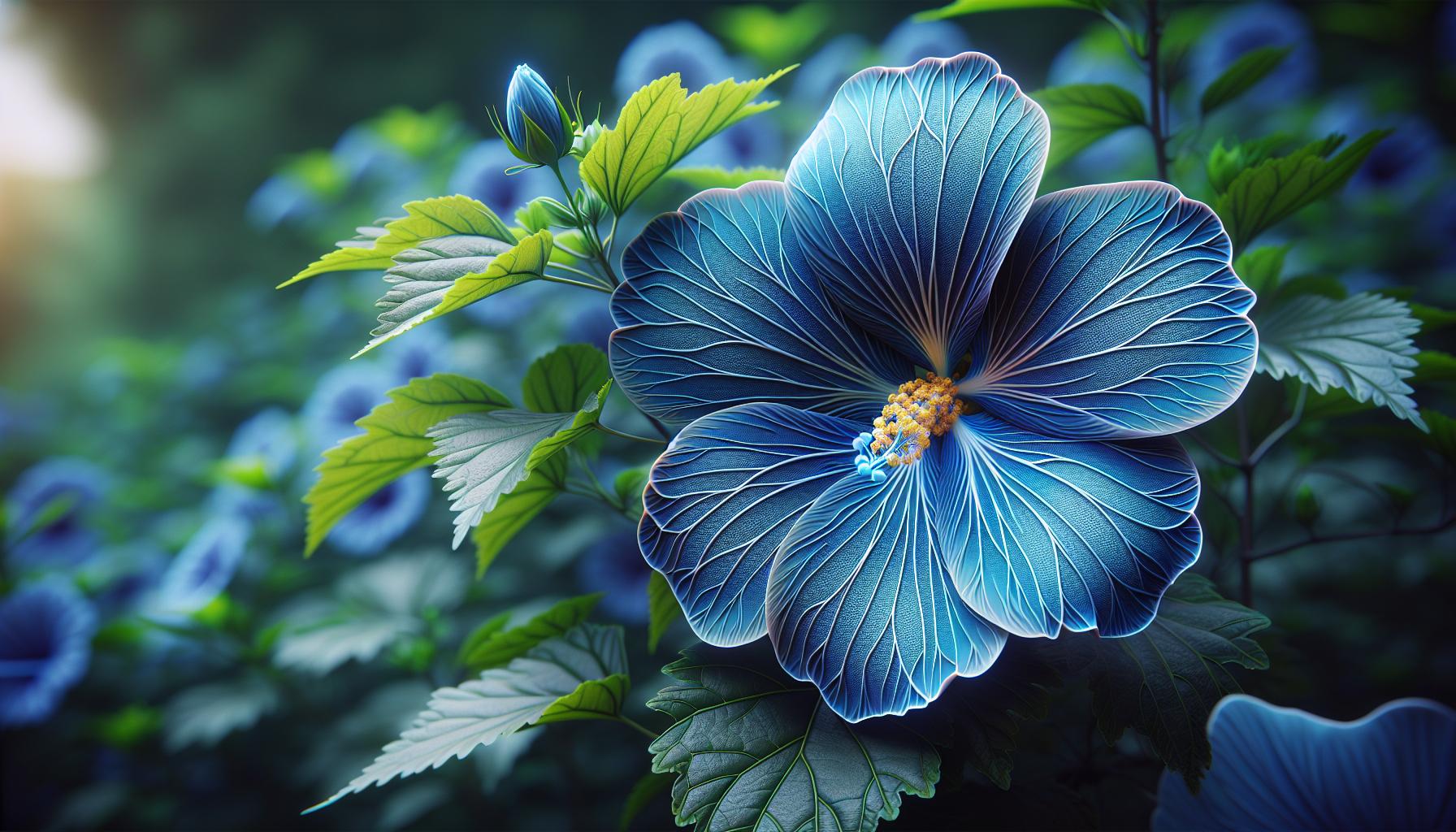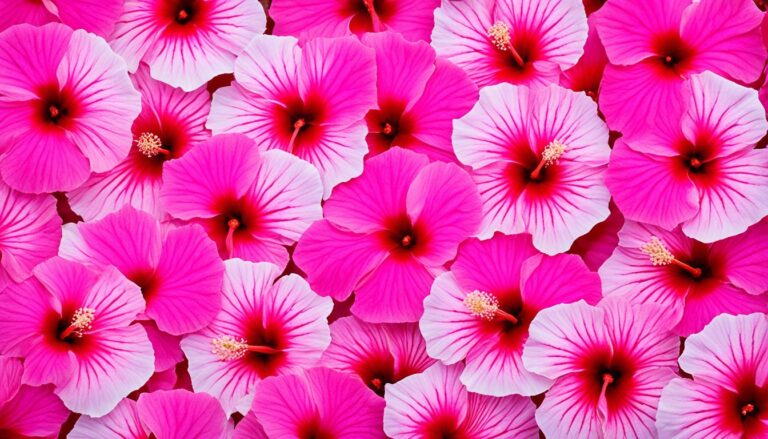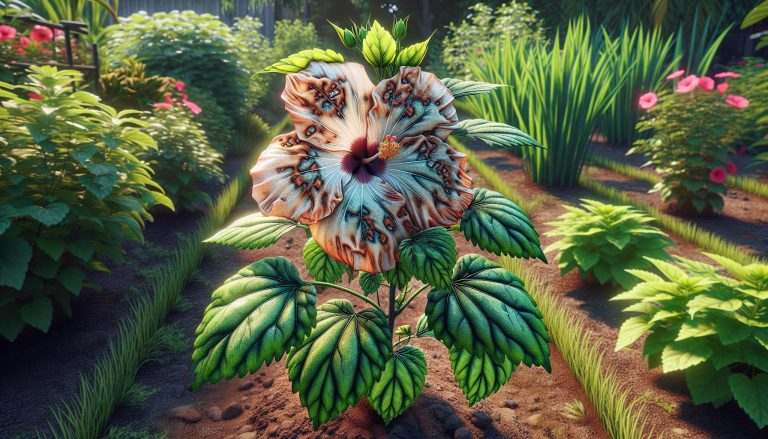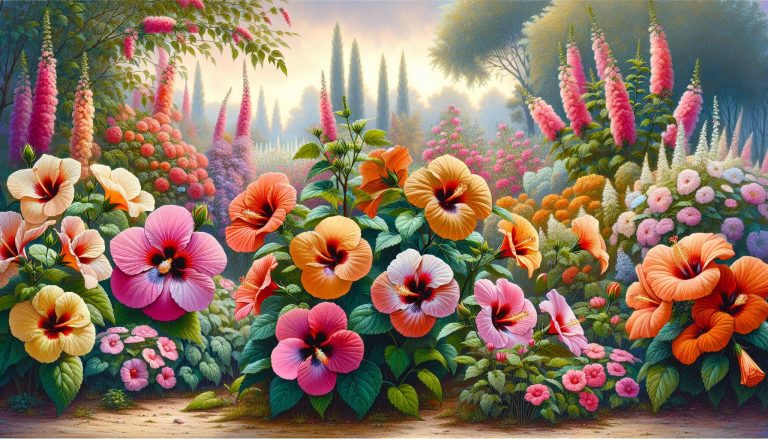Blue Hibiscus: Grow, Preserve, and Arrange Australia’s Stunning Native Flower
As I strolled through my garden, a vibrant blue flower caught my eye. It was a blue hibiscus, a stunning variety that’s often overlooked in favor of its more common red and pink cousins. Did you know that blue hibiscus isn’t actually a true hibiscus? It’s a fascinating plant with a rich history and unique characteristics.
Blue hibiscus, scientifically known as Alyogyne huegelii, is native to Australia and has been captivating gardeners worldwide with its striking azure blooms. But what makes this plant so special, and how can you successfully grow it in your own garden? I’ll dive into everything you need to know about this beautiful flower, from its care requirements to its potential uses in landscaping and beyond.
What Is Blue Hibiscus?
Blue hibiscus, scientifically known as Alyogyne huegelii, is a striking flowering shrub native to Australia. Despite its common name, it’s not a true hibiscus but belongs to the Malvaceae family.
Origins and Botanical Classification
Alyogyne huegelii hails from the coastal regions of Western and South Australia. It’s closely related to true hibiscus plants but belongs to a separate genus. Botanists classify it in the Alyogyne genus, which includes only three species. This plant’s unique genetic makeup sets it apart from its hibiscus cousins, contributing to its distinctive characteristics.
Physical Characteristics
Blue hibiscus boasts large, showy flowers that measure 3-4 inches in diameter. The blooms feature five overlapping petals in a vibrant blue-purple hue. Here’s a breakdown of its key physical traits:
- Flowers: Lavender-blue, cup-shaped, with prominent yellow stamens
- Leaves: Dark green, deeply lobed, and palmate
- Height: Typically grows 6-8 feet tall and 4-6 feet wide
- Stems: Woody and upright
| Feature | Description |
|---|---|
| Flower Color | Lavender-blue |
| Flower Size | 3-4 inches |
| Leaf Shape | Palmate, deeply lobed |
| Plant Height | 6-8 feet |
| Plant Width | 4-6 feet |
The blue hibiscus’s foliage is equally striking. Its leaves are deeply lobed, reminiscent of maple leaves, and provide an attractive backdrop for the vibrant flowers. The plant’s overall growth habit is bushy and upright, making it an excellent choice for hedges or as a focal point in garden designs.
Growing Blue Hibiscus
Blue hibiscus thrives in specific conditions that mimic its native Australian habitat. I’ll share proven techniques for cultivating this stunning plant successfully.
Ideal Climate and Soil Conditions
Blue hibiscus flourishes in warm, frost-free climates. It’s hardy in USDA zones 9-11. The plant prefers:
- Full sun to partial shade
- Well-draining, slightly acidic soil (pH 6.0-6.5)
- Protection from strong winds
- Moderate humidity levels
In colder regions, grow blue hibiscus in containers and move indoors during winter. Ensure the soil mix is rich in organic matter and provides excellent drainage.
Planting and Care Tips
To cultivate healthy blue hibiscus plants:
- Plant in spring or early summer
- Space plants 4-6 feet apart
- Water deeply and regularly, especially during dry spells
- Fertilize monthly with a balanced, slow-release fertilizer
- Prune annually after flowering to maintain shape
| Care Aspect | Frequency | Notes |
|---|---|---|
| Watering | 1-2 times/week | Increase in hot weather |
| Fertilizing | Monthly | Use 10-10-10 NPK ratio |
| Pruning | Annually | After blooming season |
Mulch around the base to retain moisture and suppress weeds. Monitor for pests like aphids and spider mites. Treat infestations promptly with insecticidal soap or neem oil.
For optimal growth, provide a trellis or support structure. Blue hibiscus can be trained as a small tree or maintained as a bushy shrub through regular pruning.
Uses of Blue Hibiscus
Blue hibiscus offers a range of applications, from enhancing garden aesthetics to providing potential health benefits. Here’s how this versatile plant can be utilized:
Ornamental Gardening
Blue hibiscus excels as an ornamental plant, adding a unique touch to gardens and landscapes. Its large, vibrant blue-purple flowers create stunning focal points in various settings:
- Hedges: Plant blue hibiscus in rows to form a colorful, natural privacy screen.
- Container gardens: Grow in large pots on patios or balconies for a dramatic display.
- Accent plants: Use as standalone specimens to draw attention to specific areas.
- Mixed borders: Combine with other flowering plants for a diverse, eye-catching garden bed.
The plant’s deeply lobed leaves provide additional visual interest, complementing its showy blooms. For best results, place blue hibiscus in full sun locations where its flowers can shine.
Medicinal Applications
While primarily grown for ornamental purposes, blue hibiscus has potential medicinal uses:
- Antioxidant properties: The flowers contain compounds that may help combat free radicals.
- Skin health: Some traditional practices use hibiscus extracts in skincare routines.
- Digestive aid: Hibiscus tea is sometimes consumed to support digestive health.
| Potential Benefit | Plant Part Used | Common Application |
|---|---|---|
| Antioxidant boost | Flowers | Tea or extract |
| Skin care | Flowers, leaves | Topical treatments |
| Digestive support | Flowers | Herbal tea |
It’s important to note that while these applications exist in traditional medicine, scientific research on blue hibiscus specifically is limited. Always consult a healthcare professional before using any plant for medicinal purposes.
Cultural Significance of Blue Hibiscus
Blue hibiscus holds a special place in various cultures around the world. Its striking appearance and unique color have made it a symbol of beauty and rarity in many societies.
Symbolism and Folklore
Blue hibiscus symbolizes peace, tranquility, and spiritual enlightenment in some cultures. In Hawaiian folklore, it’s associated with royalty and power. The flower’s vibrant blue hue represents:
- Wisdom and knowledge
- Calm and serenity
- Loyalty and trust
- Divine protection
Ancient Polynesians believed blue hibiscus could ward off evil spirits. They often planted these flowers around their homes as a protective barrier.
Use in Art and Literature
Artists and writers have long been inspired by the blue hibiscus. Its distinctive appearance makes it a popular subject in:
- Paintings: Often featured in tropical landscapes and still life compositions
- Poetry: Symbolizing beauty, rarity, and exotic locales
- Tattoo art: Representing personal transformation and growth
In literature, blue hibiscus frequently appears as a metaphor for uniqueness and resilience. Writers use it to evoke images of tropical paradises and to symbolize characters who stand out from the crowd.
Famous works featuring blue hibiscus include:
| Art Form | Title | Artist/Author |
|---|---|---|
| Painting | “Blue Hibiscus Dream” | Maria Tropical |
| Novel | “The Secret of the Blue Hibiscus” | J.K. Palmerson |
| Poem | “Ode to a Blue Hibiscus” | Lila Blueflower |
The blue hibiscus’s cultural significance extends beyond its aesthetic appeal, making it a powerful symbol in various forms of artistic expression.
Blue Hibiscus Varieties
Blue hibiscus varieties offer gardeners a stunning array of options to enhance their landscapes. From popular cultivars to rare species, these plants bring unique beauty and diversity to gardens worldwide.
Popular Cultivars
Blue hibiscus cultivars have gained popularity among gardeners for their eye-catching blooms and adaptability. Here are some of the most sought-after varieties:
- ‘Monterey Bay’: Featuring large, lavender-blue flowers with prominent stamens
- ‘Swan River’: Boasting delicate, pale blue petals with a darker center
- ‘Blue Bird’: Known for its vibrant, azure-blue blossoms that attract pollinators
- ‘Crystal Falls’: Displaying soft, powder-blue flowers with ruffled edges
These cultivars thrive in well-draining soil and full sun exposure. I’ve found that ‘Monterey Bay’ is particularly resilient, even in slightly cooler climates.
Rare and Unique Species
While less common, rare blue hibiscus species offer collectors and enthusiasts exciting opportunities:
- Alyogyne hakeifolia: Native to Australia, this species showcases distinctive, deeply lobed leaves and pale blue flowers
- Hibiscus arnottianus subsp. immaculatus: A Hawaiian native with pure white flowers and blue pollen
- Hibiscus mutabilis ‘Plena Caerulea’: A rare double-flowered form that changes color from blue to pink
Growing these rare species often requires specific conditions. For example, H. arnottianus subsp. immaculatus needs high humidity and protection from strong winds to thrive.
To successfully cultivate these unique varieties:
- Research their specific care requirements
- Provide appropriate soil pH and nutrients
- Monitor water needs closely
- Protect from extreme weather conditions
By incorporating both popular cultivars and rare species, gardeners can create a diverse and captivating blue hibiscus collection that stands out in any landscape.
Preserving Blue Hibiscus
Blue hibiscus flowers can be preserved to extend their beauty beyond their natural lifespan. Proper preservation techniques allow you to enjoy these stunning blooms in various forms long after their growing season has ended.
Drying Techniques
Drying blue hibiscus flowers is a straightforward process that yields beautiful results. Here are some effective methods:
- Air drying:
- Cut stems at a 45-degree angle
- Remove leaves
- Hang upside down in a dark, dry area
- Allow 2-3 weeks for complete drying
- Silica gel drying:
- Cover flowers in silica gel in an airtight container
- Leave for 3-5 days
- Gently remove and brush off excess gel
- Microwave drying:
- Place flowers between two microwave-safe plates
- Microwave in 30-second intervals
- Check frequently to avoid over-drying
| Method | Drying Time | Best For |
|---|---|---|
| Air | 2-3 weeks | Large quantities |
| Silica gel | 3-5 days | Preserving shape and color |
| Microwave | 2-3 minutes | Quick results |
These methods preserve the blue hibiscus’s delicate beauty, allowing you to create long-lasting floral displays or crafts.
Creating Floral Arrangements
Blue hibiscus flowers add a unique touch to floral arrangements. Here’s how to incorporate them effectively:
- Fresh arrangements:
- Cut stems early morning or late evening
- Place in lukewarm water immediately
- Recut stems underwater before arranging
- Use floral preservative to extend vase life
- Dried arrangements:
- Combine with other dried flowers like lavender or roses
- Use floral wire to support stems if needed
- Spray with UV-resistant floral spray to maintain color
- Mixed arrangements:
- Pair dried blue hibiscus with fresh greenery
- Use as a focal point in tropical-themed bouquets
- Incorporate into wreaths or garlands for lasting decor
Tips for stunning arrangements:
- Contrast blue hibiscus with complementary colors like yellow or orange
- Use odd numbers of flowers for a balanced look
- Vary flower heights and sizes for visual interest
By mastering these preservation and arranging techniques, you’ll be able to showcase the beauty of blue hibiscus in your home year-round.
Conclusion
The blue hibiscus is truly a remarkable flower that captivates with its beauty and versatility. From its Australian origins to its global significance, this stunning bloom offers endless possibilities for garden enthusiasts and floral artists alike. Whether you’re cultivating rare varieties, preserving blooms, or creating eye-catching arrangements, the blue hibiscus never fails to impress. I hope this guide has inspired you to explore the world of blue hibiscus and incorporate its magic into your own botanical adventures. With proper care and creativity, you’ll be able to enjoy the allure of this extraordinary flower year-round.






